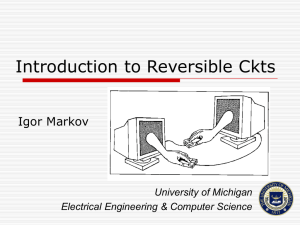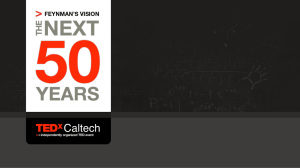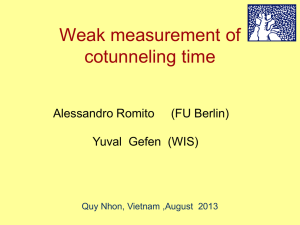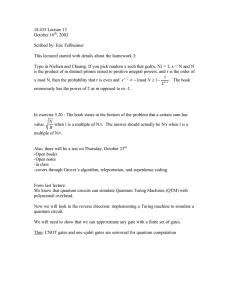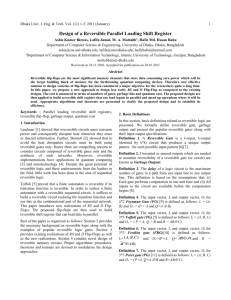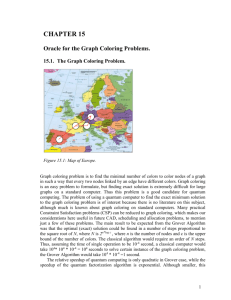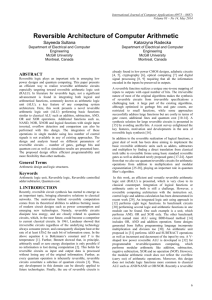Qu Computing - Physics & Astronomy
advertisement
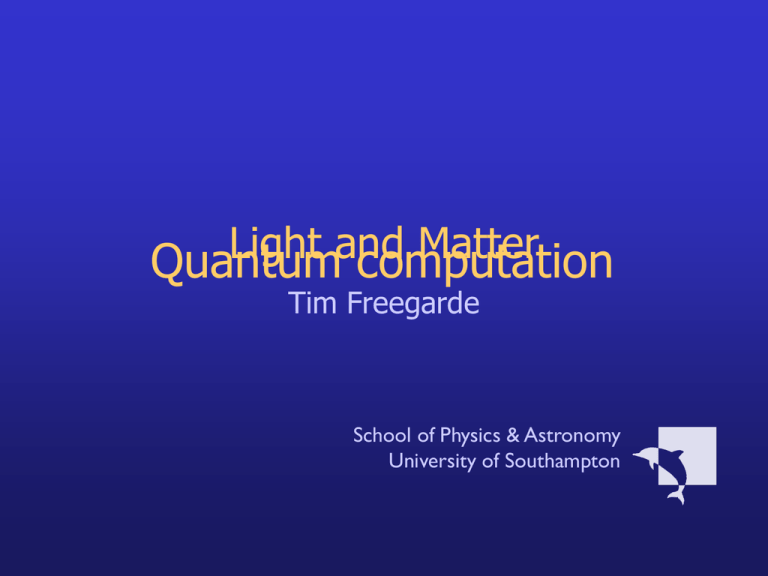
Light and Matter Quantum computation Tim Freegarde School of Physics & Astronomy University of Southampton Binary computing elements • any computer can be built from 2-bit logic gates A • e.g. half-adder circuit • gates are not reversible: output does not define input A B C 0 0 1 1 0 1 0 1 1 1 1 0 A B C 0 0 1 1 0 1 0 1 0 1 1 0 A B C D 0 0 1 1 0 1 0 1 0 0 0 1 0 1 1 0 C B NAND A C B XOR A B D C HALF-ADDER carry sum 2 Reversible binary computing elements • any computer can be built from 2-bit logic gates A • e.g. half-adder circuit • gates are not reversible: output does not define input • for reversible gates, additional outputs needed A B C 0 0 1 1 0 1 0 1 1 1 1 0 A B C A 0 0 1 1 0 1 0 1 0 1 1 0 0 0 1 1 A B C D A 0 0 1 1 0 1 0 1 0 0 0 1 0 1 1 0 0 0 1 1 C B NAND A A C B XOR A B D C HALF-ADDER carry sum 3 Reversible binary computing elements • any computer can be built from 2-bit logic gates A • e.g. half-adder circuit • gates are not reversible: output does not define input • for reversible gates, additional outputs needed A B C 0 0 1 1 0 1 0 1 1 1 1 0 A B C A 0 0 1 1 0 1 0 1 0 1 1 0 0 0 1 1 A B C D A 0 0 1 1 0 1 0 1 0 0 0 1 0 1 1 0 0 0 1 1 C B NAND A A C B XOR A A B 0 D C A A CNOT B 0 CCNOT (Toffoli) HALF-ADDER D C carry sum 4 Thermodynamics of computation • thermodynamic quantities are associated with any physical storage of information • e.g. entropy 0 1 S k log W • setting a binary bit reduces entropy by S k log 2 k log 1 k log 2 • hence energy consumption Q T S k T log 2 • reversible logic does not change change is slow W ; no energy consumed if • note that conventional logic gates consume 106 kT 5 Quantum computing • each data bit corresponds to a single quantum property • • • • electronic or nuclear spin of atom or molecule electronic state of atom or molecule polarization state of single photon vibrational or rotational quantum number 1 • e.g. electron spins in magnetic field gradient • operations carried out as Rabi -pulses • evolution described by Schrödinger’s equation E 1 B A 0 0 • electromagnetic interactions between trapped ions lift degeneracies in radiative transitions 1 D C 11 B A CNOT 10 01 00 6 Quantum computing • tiny, reversible quantum bits (qubits) for small, fast, low power computers • complex wavefunctions may be superposed: 0 1 B 0 1 A 00 01 10 11 1 1 1 B A • parallel processing: result is F 00 F 01 F 10 F 11 0 0 E D • classical read-out: probabilistic results • limited algorithms: • factorization (encryption security) • parallel searches (data processing) C 11 B A CNOT 10 01 00 7 Quantum computing • extension of computing from real, binary numbers to complex, continuous values • extension of error-correction algorithms from digital computers to analogue computers 1 • link between numerical and physical manipulation • is quantum mechanics part of computation, or computation part of quantum mechanics? E • statistical properties (the measurement problem) 1 B A 0 0 • extension of quantum mechanics to increasingly complex ensembles 1 D C 11 B A CNOT 10 01 00 8 Quantum information processing classical mechanics Galileo 1564 Kepler 1571 Newton 1642 H G Wells 1866 A C Clarke 1917 quantum optics observe Fraunhofer 1787 describe Balmer 1825 Planck 1858 understand Einstein 1879 predict exploit Townes 1915 Schawlow 1921 quantum mechanics Compton 1892 Hertz 1887 De Broglie 1892 Schrödinger 1887 Heisenberg 1901 Feynman 1918 9 Further reading • R P Feynman, Feynman Lectures on Computation, Addison-Wesley (1996) • A Turing, Proc Lond Math Soc ser 2 442 230 (1936) • D Deutsch, “Quantum theory, the Church-Turing principle and the universal quantum computer,” Proc Roy Soc Lond A 400 97 (1985) • D P DiVicenzo, “Two-bit gates are universal for quantum computation,” Phys Rev A 51 1015 (1995) • C H Bennett, P A Benioff, T J Toffoli, C E Shannon • www.qubit.org 10

